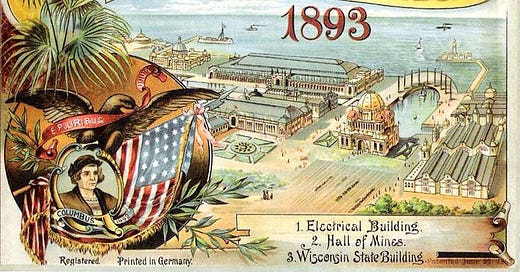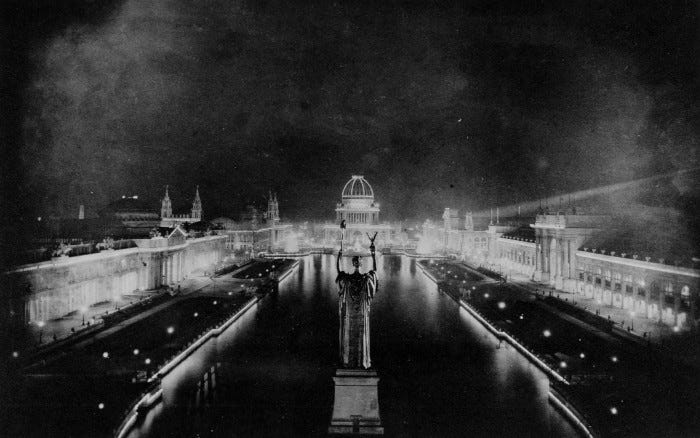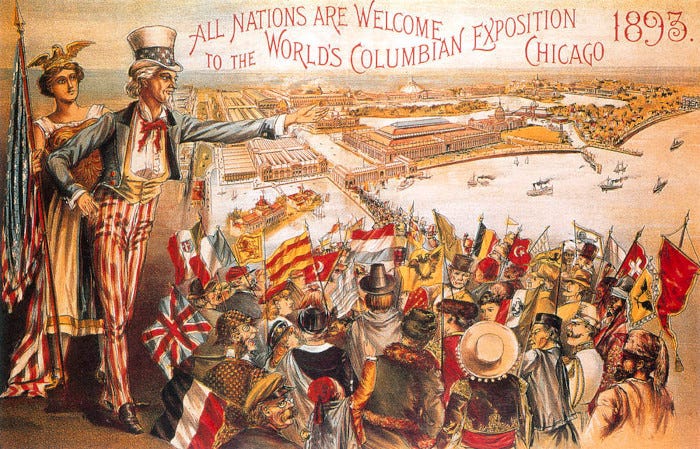– 14 October 2024 –
Barzillai “19th Century” Bozarth:
Via the Pawtucket Tribune, Pawtucket, Rhode Island; 22 October 1892:
THE FOUR HUNDRED YEARS FROM COLUMBUS TO THE WORLD’S FAIR.
A MOST WONDERFUL ERA,
What Time Has Evolved Since the Days of Ferdinand and Isabella
It is a “far cry,” as the Scotch say, from Columbus to Chicago, but one is responsible for the other, and across the vast space of 400 busy years the Spirit of Discovery will clasp hands with the Spirit of Progress at the fast approaching dedicatory ceremonies of the great World’s fair, which is to mark at once the close and the beginning of an epoch.
These, as the French phrase it, are “end of the age” days, and in a sense they are, for the tremendous Nineteenth century is drawing to its finality and not long hence will be historic rather than actual. Therefore it is fitting that the preparations and plans for the Chicago display should include not only trophies of present achievement, but also tangible exhibits of past endeavor.
And what a magnificent period it is to be commemorated by these preliminary pageants at Jackson park! No other volume of man’s record so teems with tales of toil and success. First the discovery of the New World: then the exploration; after that the conquest and settlement; the creation of new states, and finally the vindication of the principle of the republic, for from pole to pole not a monarchy exists. The British possessions are practically autonomous, and a Canadian premier has more to say about the conduct of Dominion affairs than the queen and the parliament at Westminster.
Then think of the heroes who followed in the train of Columbus and made effective his discoveries. True, many were actuated in their trials and triumphs only by the lust for gold, but the results remain the same whatever may have been their original purpose. What a crowd of splendid spirits flit before the mental vision’ Cortez and Pizarro overthrowing the ancient dynasties of Montezuma and the Incas; Balboa planting the flag of Spain on the shores of the Pacific; Ponce de Leon hunting for the Fountain of Youth in the glades of Florida; De Soto struggling westward in his futile search for gold: Coronado crossing the deserts of the southwest that he might reach the famed but fabulous Seven Cities of Cibola; the founding of St. Augustine and Santa Fe. Then the voyage of Hendrick Hud son; the landing of the Pilgrim Fathers; the establishment of the Jamestown colony; the rivalry of Dutch, English and French; the wars with the Indians, and the final supremacy of the Anglo-Saxon race.
How the names of the heroes of that formative period rise up in demand for recognition! Carver and Bradford and Standish, Winthrop and Penn, Williams and Eliot—but the list is long and known of all men who honor their country enough to learn her history. They were giants in those days, and they fought as relentlessly as the warriors whose deeds are recorded in the Old Testament. On sea and land it was the Latin against the Saxon, and the latter won. In the north he whipped the French, and in the south he forced back the Spaniard. All the while the restless spirit of freedom seemed to pervade the air, and after adjusting their immediate bickerings the colonies, both Latin and Saxon, set at defiance their rulers beyond the sea. The results were Washington and the United States, Iturbide and Mexican independence, Bolivar and the South American republics.
The but barely hint at some of the things which naturally suggest themselves in connection with the dedicatory ceremonies. The 400 years between Columbus and the Columbian exposition have been so stupendous in their outcomes of progress, despite woes and disasters, that it is fitting that the World’s fair should be a stupendous exponent of the doings of this mighty and unexampled era.
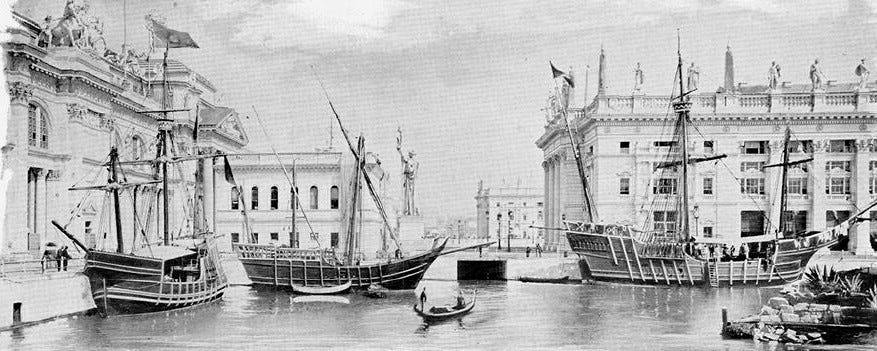
Speaking of the enterprise recently, Sir Henry Trueman Wood, the British commissioner, said:
“I suppose few people realize the immense area that will be covered by by the Chigago exhibition. It is absolutely without comparison. The site comprises Jackson park, occupying 586 acres: Washington park, a mile away, of 371 acres, and a strip of land called the Midway plaisance, connecting the two and contributing a further area of eighty acres. The latter will be converted into a bazaar and street of nations, and a sliding water railway, very like the one in the Paris exhibition of 1889, will run along the whole length. There is a total of 1,037 acres available for the purposes of the exhibition. The Washington park will not probably be built upon, so that the ground actually covered will be about 660 acres—that is, four times as great as that of the French exhibition in 1889….”
[. . .]
While the ceremonies dedicatory of the buildings extend over three days and include as attendant a mammoth civic parade, military maneuvers and review, gorgeous displays of fireworks and a grand ball, the chief interest naturally centers in the dedication exercises proper, on Oct. 21. These will be held in the presence of 125,000 people in the building for Manufactures and Liberal Arts, already famous as the largest building in the world.

It is interesting to read about this stupendous structure. It is awe inspiring to contemplate the vast expanse of its exterior or stand within it and with the eye measure its gigantic proportions. By many this great building will be regarded as distinctive a feature of the fair of 1893 as was the Eiffel tower of the Paris exposition of 1889. From a mere statement of the dimensions of this monster structure one can get but a faint idea of its immense size. A few comparisons will assist greatly. One has to travel almost a mile in walking around it. […]
Janus:
In many ways, one feels great nostalgia and affection for the place and times of the World’s Columbian Exposition in Chicago, celebrated from July to October in 1893. The Exposition continued the recent spectacles of industrial-age world’s fairs, with their grand exhibits of science and industry, this one commemorating the 400th anniversary of Christopher Columbus’ discovery of America. The 1890’s marked the very zenith of the power and glory of Western civilization, and amounted to a kind of golden age of seemingly boundless peace, progress, and wonder.
Yet the Exposition had a darker side, however unwittingly. This celebration of Columbus’ discovery gloried in collective human pride and secular internationalism. The 1893 World’s Fair showcased the material achievements of humanity divorced from our past. The history it honored merely served as a backdrop for the progress that Europeans had achieved, seemingly all by ourselves, since 1492.
And where did Christianity fit in? While various churches and religious organizations maintained booths within a section of the Exposition, some of them, such as America’s Presbyterians, protested the fact that the event remained largely open on Sundays. Even more ominous was the concurrent World Parliament of Religions, the first of its kind in history, open to many non-Christian religious representatives of the world’s main religions, and including the Theosophists and other “new religious” movements.
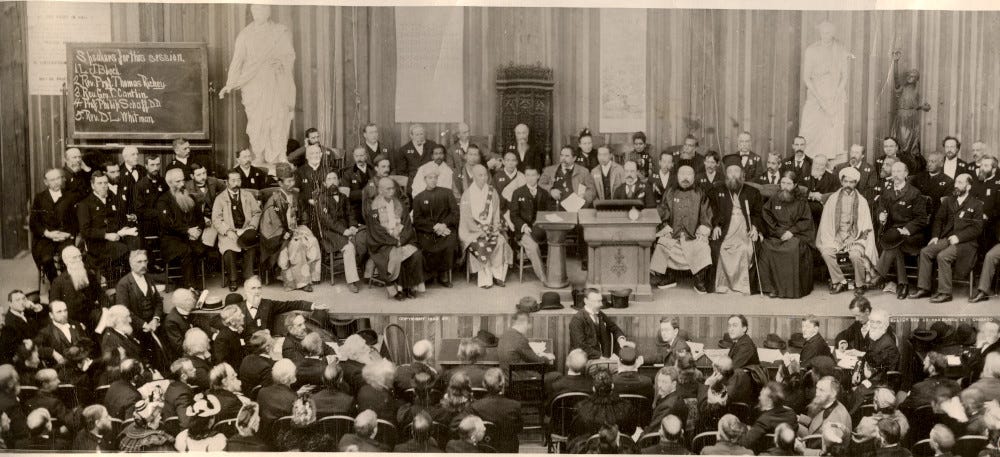
In effect, the World’s Fair—as beautiful, exciting, and awe-inspiring as it was—served (along with the new Olympic Games that began in 1896) as the beginnings of a new Tower of Babel, with humanity coming together to declare that we were transcending primitive faith and prejudice and launching a new era built on the marvels of science, engineering, and collective unity.

